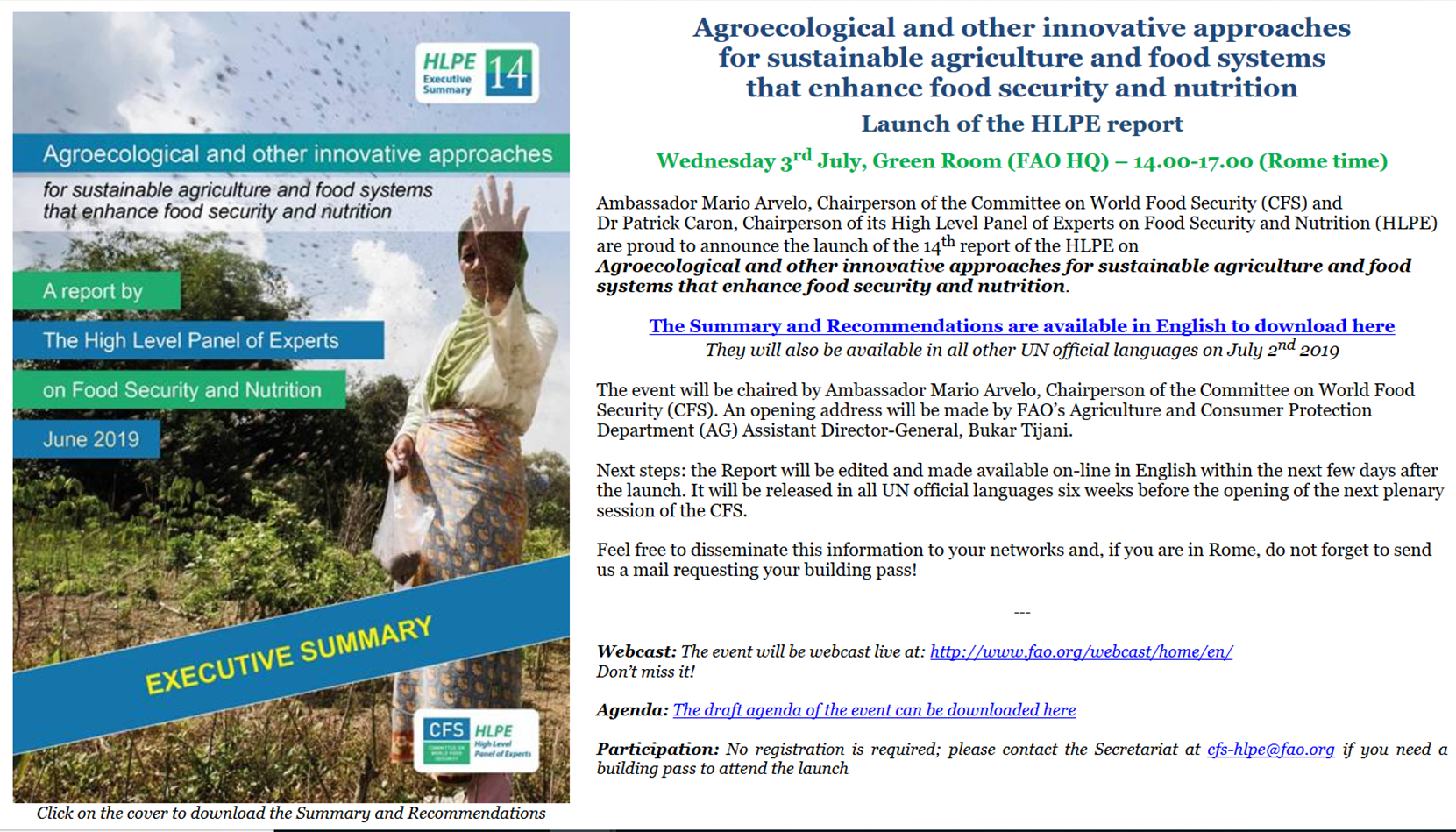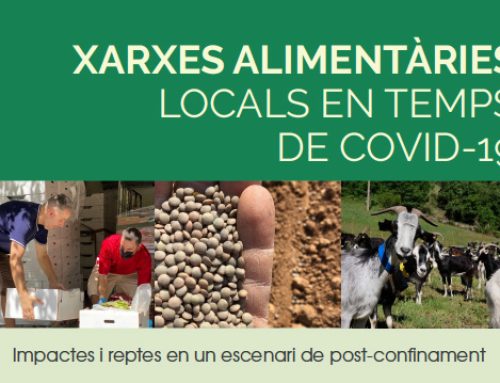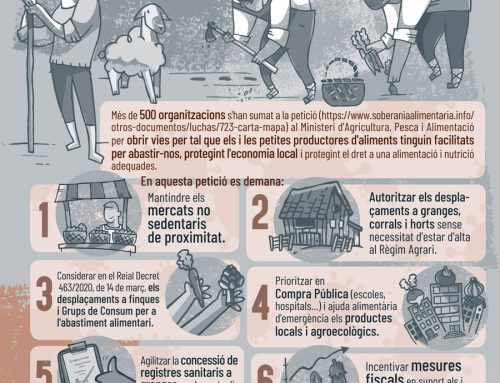El día 3 de julio en Australia la organización de las Naciones Unidas para la Agricultura y la Alimentación (FAO) presenta el nuevo informe del panel de alto nivel de expertos del comité de seguridad alimentaria de las naciones unidas en el que evalúan el papel de la agroecología en la transición a sistemas alimentarios sostenibles y nutritivos. El resumen del informe lo podéis bajar aquí
Adjuntamos aquí las principales conclusiones:
AGROECOLOGY: TRANSITION PATHWAYS TOWARDS SUSTAINABLE FOOD SYSTEMS
1. Agroecology is a dynamic concept that has gained prominence in scientific, agricultural and political discourse in recent years. It is increasingly promoted as being able to contribute to transforming food systems by applying ecological principles to agriculture and ensuring a regenerative use of natural resources and ecosystem services while also addressing the need for socially equitable food systems within which people can exercise choice over what they eat and how and where it is produced. Agroecology embraces a science, a set of practices and a social movement and has evolved over recent decades to expand in scope from a focus on fields and farms to encompass whole agriculture and food systems. It now represents a transdisciplinary field that includes all the ecological, sociocultural, technological, economic and political dimensions of food systems, from production to consumption.
2. Agroecology is a transdisciplinary science, combining different scientific disciplines to seek solutions to real world problems, working in partnership with multiple stakeholders, considering their local knowledge and cultural values, in a reflective and iterative way that fosters co-learning among researchers and practitioners, as well as the horizontal spread of knowledge from farmer to farmer or among other actors along the food chain. Initially the science was focused on understanding field-level farming practices that use few external inputs but high agrobiodiversity, emphasize recycling and maintenance of soil and animal health, including managing interactions among components and economic diversification. The focus has since expanded to include landscape-scale processes, encompassing landscape ecology and, more recently, social science and political ecology related to the development of equitable and sustainable food systems.
3. Agroecological practices harness, maintain and enhance biological and ecological processes in agricultural production, in order to reduce the use of purchased inputs that include fossil fuels and agrochemicals and to create more diverse, resilient and productive agroecosystems. Agroecological farming systems value, inter alia: diversification; mixed cultivation; intercropping; cultivar mixtures; habitat management techniques for crop-associated biodiversity; biological pest control; improvement of soil structure and health; biological nitrogen fixation; and recycling of nutrients, energy and waste. There is no definitive set of practices that could be labelled as agroecological, nor clear, consensual boundaries between what is agroecological and what is not. On the contrary, agricultural practices can be classified along a spectrum and qualified as more or less agroecological, depending on the extent to which agroecological principles are locally applied. In practice this comes down to the extent to which: (i) they rely on ecological processes as opposed to purchased inputs; (ii) they are equitable, environmentally friendly, locally adapted and controlled; and (iii) they adopt a systems approach embracing management of interactions among components, rather than focusing only on specific technologies.
5. Social movements associated with agroecology have often arisen in response to agrarian crises and operated together with broader efforts to initiate widespread change to agriculture and food systems. Agroecology has become the overarching political framework under which many social movements and peasant organizations around the world assert their collective rights and advocate for a diversity of locally adapted agriculture and food systems mainly practised by small-scale food producers. Social movements highlight the need for a strong connection to be made between agroecology, the right to food and food sovereignty. They position agroecology as a political struggle, requiring people to challenge and transform the structures of power in society.
6. There have been many attempts to set out principles of agroecology in the scientific literature. This report suggests a concise and consolidated set of 13 agroecological principles related to: recycling; reducing the use of inputs; soil health; animal health and welfare; biodiversity; synergy (managing
interactions); economic diversification; co-creation of knowledge (embracing local knowledge and global science); social values and diets; fairness; connectivity; land and natural resource governance; and participation.
7. An agroecological approach to SFSs is defined as one that favours the use of natural processes, limits the use of external inputs, promotes closed cycles with minimal negative externalities and stresses the importance of local knowledge and participatory processes that develop knowledge and practice through experience, as well as scientific methods, and the need to address social inequalities. This has profound implications for how research, education and extension are organized. An agroecological approach to SFSs recognizes that agri-food systems are coupled with social-ecological systems from the production of food to its consumption with all that goes on in between. It involves agroecological science, agroecological practices and an agroecological social movement, as well as their holistic integration, to address FSN.
8. Agroecology is practised and promoted in various locally adapted forms by many farmers and other
food system actors around the world. Their experience underpins a continuing debate about the extent to which agroecological approaches can contribute to design SFSs that achieve FSN at all levels. This debate revolves around the following three critical issues. (i) How much food needs to be produced to achieve FSN; centred on whether FSN is mainly a problem of availability or more an issue of access and utilization? (ii) Could agroecological farming systems produce enough food to meet global demand for food? (iii) How to measure the performance of food systems, taking into account the many environmental and social externalities that have often been neglected in past assessments of agriculture and food systems?
9. There is no single, consensual definition of agroecology shared by all the actors involved, nor agreement on all the aspects embedded in this concept. While this makes it hard to pin down exactly what is agroecology and what is not, it also provides a flexibility that allows agroecological approaches to develop in locally adapted ways. There can be tensions and diverging views between science and social movements around whether social and political dimensions are critical for agroecology to be effectively transformative and whether these dimensions should be distinguished from agroecological practices and techniques focused at field and farm scales. There are emerging efforts to define which agricultural practices are agroecological or not, allied to discussions about convergence or divergence with organic agriculture, which is more prescriptive, and about the development and use of certification schemes.
10. There has been much less investment in research on agroecological approaches than on other
innovative approaches, resulting in significant knowledge gaps including on: relative yields and performance of agroecological practices compared to other alternatives across contexts; how to link agroecology to public policy; the economic and social impacts of adopting agroecological approaches; the extent to which agroecological practices increase resilience in the face of climate change; and how to support transitions to agroecological food systems, including overcoming lockins and addressing risks that may prevent them.
11. Five phases have been identified by Gliessman (2007) in making agroecological transitions towards more sustainable food systems. The first three operate at the agroecosystem level and involve: (i) increasing input use efficiency; (ii) substituting conventional inputs and practices with agroecological alternatives; and iii) redesigning the agroecosystem on the basis of a new set of ecological processes. The remaining two steps operate across the whole food system and involve: (iv) re-establishing a more direct connection between producers and consumers; and (v) building a new global food system based on participation, localness, fairness and justice. While the first two steps are incremental, the latter three are more transformative





